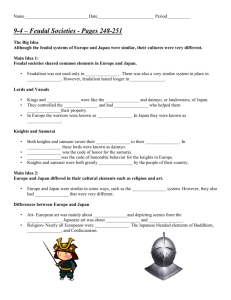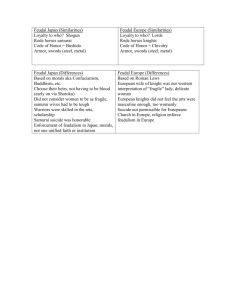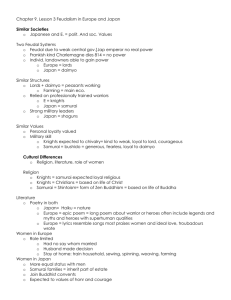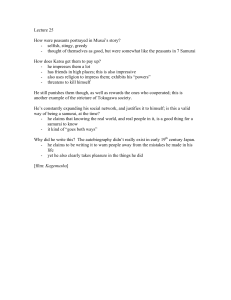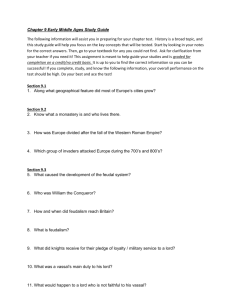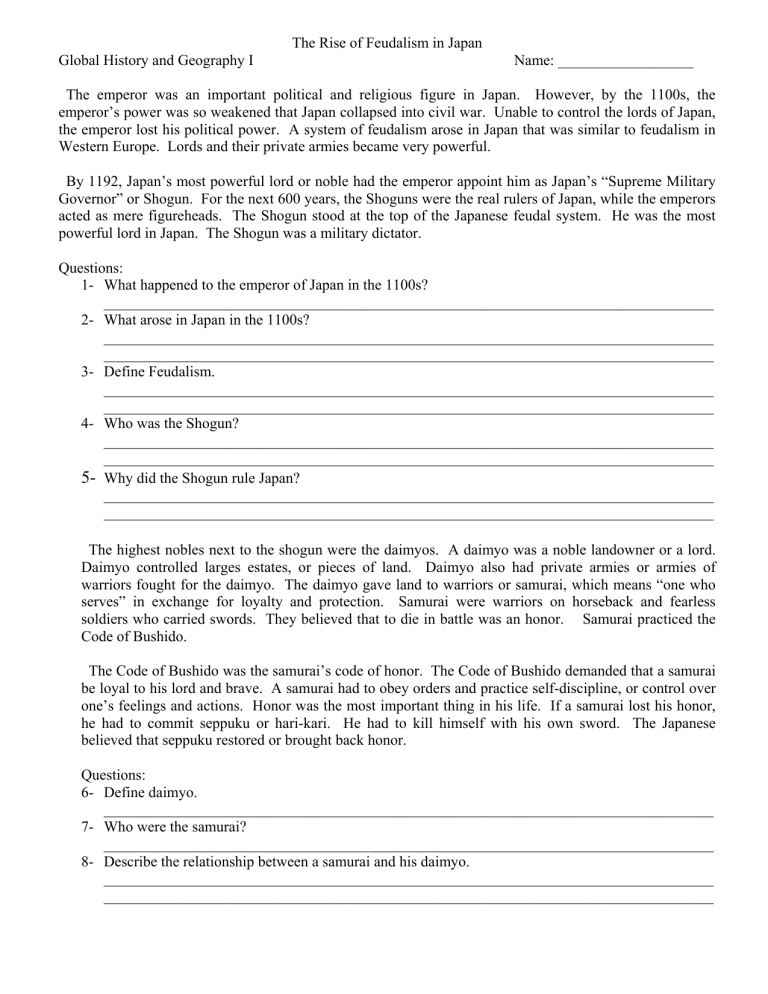
The Rise of Feudalism in Japan
Global History and Geography I Name: __________________
The emperor was an important political and religious figure in Japan. However, by the 1100s, the emperor’s power was so weakened that Japan collapsed into civil war. Unable to control the lords of Japan, the emperor lost his political power. A system of feudalism arose in Japan that was similar to feudalism in
Western Europe. Lords and their private armies became very powerful.
By 1192, Japan’s most powerful lord or noble had the emperor appoint him as Japan’s “Supreme Military
Governor” or Shogun. For the next 600 years, the Shoguns were the real rulers of Japan, while the emperors acted as mere figureheads. The Shogun stood at the top of the Japanese feudal system. He was the most powerful lord in Japan. The Shogun was a military dictator.
Questions:
1What happened to the emperor of Japan in the 1100s?
_________________________________________________________________________________
2What arose in Japan in the 1100s?
_________________________________________________________________________________
_________________________________________________________________________________
3Define Feudalism.
_________________________________________________________________________________
_________________________________________________________________________________
4Who was the Shogun?
_________________________________________________________________________________
_________________________________________________________________________________
5Why did the Shogun rule Japan?
_________________________________________________________________________________
_________________________________________________________________________________
The highest nobles next to the shogun were the daimyos. A daimyo was a noble landowner or a lord.
Daimyo controlled larges estates, or pieces of land. Daimyo also had private armies or armies of warriors fought for the daimyo. The daimyo gave land to warriors or samurai, which means “one who serves” in exchange for loyalty and protection. Samurai were warriors on horseback and fearless soldiers who carried swords. They believed that to die in battle was an honor. Samurai practiced the
Code of Bushido.
The Code of Bushido was the samurai’s code of honor. The Code of Bushido demanded that a samurai be loyal to his lord and brave. A samurai had to obey orders and practice self-discipline, or control over one’s feelings and actions. Honor was the most important thing in his life. If a samurai lost his honor, he had to commit seppuku or hari-kari. He had to kill himself with his own sword. The Japanese believed that seppuku restored or brought back honor.
Questions:
6Define daimyo.
_________________________________________________________________________________
7Who were the samurai?
_________________________________________________________________________________
8Describe the relationship between a samurai and his daimyo.
_________________________________________________________________________________
_________________________________________________________________________________
9What was the Code of Bushido?
_________________________________________________________________________________
_________________________________________________________________________________
10How could a samurai regain his honor?
_________________________________________________________________________________
_________________________________________________________________________________
Japanese feudalism and European feudalism were similar in many ways but there were several differences.
In Europe, when a lord died, the oldest son generally inherited his land. In Japan, a man chose the son who could best take care of the land or if he had no heir, he could adopt a son. In Europe, women were considered weak even though respected. In Japan, samurai expected their wives to be tough and selfdisciplined. Finally, knights did not think education was important but samurai valued education.
List three differences between Japanese and European Feudalism:
1________________________________________________________
2________________________________________________________
3________________________________________________________
In an outline, one of these is the main topic and the others are sub-topics. Which is the main topic?
1- Shogun 3- Samurai
2- Daimyo 4- Japan’s Feudal Period
Which was a characteristic of feudalism in both medieval Europe and Japan?
1Merchants acquired more power than any other class.
2Political power was held by a strong central government.
3The army encouraged strong national feelings among the people.
4People pledged absolute loyalty to their social superiors.
The code of bushido of the Japanese samurai is most similar to
1.
belief in reincarnation and karma of Hindus
2.
practice of chivalry by European knights
3.
teachings of Judaism
4.
theory of natural rights of the Enlightenment writers
Feudalism in Western Europe was similar to feudalism in Japan in that
1.
power was based on class relationships
2.
equality among the social classes
3.
direct democracy
4.
monotheism
Which is a characteristic of a feudal society?
1.
rapid social change
2.
high literacy rate
3.
industrial-based economy
4.
rigid class structure
The diagram illustrates the social structure of feudal Japan.
This pyramid shows that feudal Japan had
1.
a classless society
2.
a growing middle class
3.
high social mobility
4.
a well-defined class system
The Feudal Hierarchy of Japan
Global History and Geography I Name: ___________________
Feudalism (Lords, Service, Military Service)
AUnder a feudal system, land is exchanged for _________ _________.
BPowerful _______________ own land and give land for __________.
CIn Japan, ____________ became more powerful than the emperor.
Lords in Feudal Japan (Taxes, Shogun, Daimyo, Land, Dictator)
AA powerful lord in Japan was called a _______________.
BThese powerful lords refused to pay _________ to the emperor.
CThe most powerful lord in Japan was called the ____________.
DThe most powerful lord was a military ___________________.
ELords owned _________ and exchanged ________ for service.
The Emperor in Feudal Japan (Little, Status, Shogun, god)
AThe emperor was considered a ________ in Feudal Japan.
BHe had high ________ but ____ political power.
CThe most powerful lord forced the emperor to appoint him ________.
The Samurai in Feudal Japan (Bushido, Knights, Warriors, No emotion, Discipline,
Loyalty, Seppuku, Chivalry, Honor)
AThe samurai were skilled ______________.
BThey were similar to _________ in Feudal Europe.
CThe samurai had to follow the Code of ________________.
DThe Code of ___________ was a set of rules for the samurai.
EList three rules a samurai had to follow:
1_____________________
2_____________________
3_____________________
FThe samurai lost _________ if he failed to follow the Code of Bushido.
GTo regain his honor, a samurai had to commit ______________.
HThe Code of Bushido is similar to the European concept of ________________.
The Feudal Hierarchy or System of Ranking (Samurai, Shogun, Daimyo, Peasants, Birth determines status, Birth, Yes, Education, Inheritance, Women)
1: _______________
2: _______________
3: _______________
4:
1) What determined a person’s class?
___________________
2) Is this a fixed social class system?
__________________
3) Why?
_______________________________
_______________________________
4) Where is the emperor?
_______________________________
5) Is this a hereditary social class system?
__________________
6) Why?
______________________________
______________________________
List four ways Japanese Feudalism differed from European Feudalism:
1) ____________________
2) ____________________
3) ____________________
A Japanese Story: The Samurai and the Tea Master
A long time ago there lived a great Tea Master. He was an elderly, small and frail man. He was known throughout the countryside where he lived for his beautiful Tea Ceremony. His work was so good that one day the Emperor heard about him and summoned him to the Palace to perform this special ceremony.
The quiet, little Tea Master received this invitation from the Emperor. He packed his belongings, placed them on his back and started on a long journey by foot to the Palace.
After many long days the little man arrived and performed the ceremony for the Emperor. The Emperor was so impressed! He presented the Tea Master with the highest honor that he was allowed. He presented him with the two Japanese swords of the Samurai.
The Tea Master accepted the swords. He bowed to the emperor, placed the swords on his back, picked up his belongings and started his journey home.
Two days later the little man was walking through a small country village when he was spotted by the
Samurai that protected that area. He was a great and powerful Samurai. At first the Samurai could not believe his eyes. Where those swords? What was this little frail man doing with them?!
The Samurai confronted the little man. “How dare you make a mockery of all Samurai! I can not stand for this dishonor. We will meet here on this place in the morning and correct this!”
The two men bowed to each other and went their separate ways. The Tea Master, of course, was in a panic.
What should he do?
That evening he sought the advice of an elderly Samurai teacher. The old man said, “First, in the morning, you are going to die.” Then he went silent. The Tea Master asked, “Is there nothing I can do?” The teacher replied, “Yes, make tea.”
In the morning the Tea Master and the Samurai met in the village. They bowed to each other, and then each drew their swords. The great Samurai looked down his sword at the Tea Master. The Tea Master looked down his sword with all the focus, care and attention…..of making tea.
The great Samurai stepped back, replaced his sword, bowed and said, “Please excuse me, I have been mistaken.”
The meaning of the story:
_______________________________________________________________________________________
_______________________________________________________________________________________
_______________________________________________________________________________________


